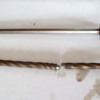Ford's oil pump drive shaft is designed to twist and absorb problems that try to stall the pump. The lower shaft is not the picture of an under-engineered or defective shaft, its the picture of a shaft that faithfully performed the job it was designed to do until the very end!
Notice how severely twisted the shaft is, that's how much twisting it takes to make a drive shaft snap in two. The normal shaft removed from a high mileage Ford may have one to two full twists in it. The shaft removed from a motor that is clean inside, maintained well by the owner, may not be twisted at all.
Passing debris is not what caused the severity of the twisting you see in this picture. The aftermarket pump in this motor had a burr inside the casing that made the pump hard to turn, and over twenty to thirty years of use the shaft slowly twisted into the shape you see.
The lesson here is not to replace the shaft with one that doesn't twist, the shafts twisting is a beneficial thing and an intentional design feature. Rather, the lesson here is to disassemble a new pump, inspect it, deburr it, and hand fit the rotors and housing for 0.0025" clearance. Thoroughly clean it, make sure its free of debris. Twist it by hand and make sure it turns freely BEFORE you install it in your motor.
Heavy duty oil pump shafts were not designed to improve the lubrication system, they were designed to benefit the ignition, they are designed to eliminate spark scatter. For the average Joe like myself, the issue of spark scatter is a moot point, I never noticed a problem caused by spark scatter; therefore the heavy duty oil pump shaft is a solution to a problem I didn't know I had.
If you don't install a heavy duty oil pump shaft in your motor you won't have a problem with shearing roll pins. The oem shaft will twist as it was designed to do.
-G
PANTERA INTERNATIONAL
A DE TOMASO CAR CLUB
Presents the De Tomaso Forums
The On-Line Meeting Place for De Tomaso Owners and Enthusiasts From Around the World
Clicking on the banner will take you to the sponsor's website.


